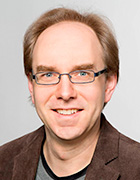
Prof. Dr. Christian Liedtke
Academic Career and Research Areas
The field of research of Professor Liedtke (b. 1976) is algebraic geometry situated at the nexus of classical, complex and arithmetic geometry. His research deals with the classification of algebraic surfaces (in particular K3 surfaces and surfaces of general type in positive characteristic), elliptic curves and fibrations, fundamental groups and the construction of rational curves.
Professor Liedtke studied mathematics at the University of Göttingen and the University of Warwick from 1996 to 2001 and graduated in 2001 under the supervision of Professor Catanese. He subsequently performed his doctoral studies under the supervision of Professor Faltings at the Max Planck Institute (MPI) for Mathematics in Bonn. After obtaining his doctoral degree in 2004 he worked as a research assistant at the University of Düsseldorf and from 2009 to 2011 he conducted research at Stanford University as a recipient of a DFG-scholarship. After his habilitation (2011), he was a Research Associate at the University of Bonn; from 2013 until his appointment as Associate Professor in 2017, he was Tenure Track Assistant Professor at TUM. Prof. Liedtke has been a Full Professor at TUM since 2022. From 2018 to 2022, he was vice dean of the department of mathematics and from 2019 to 2022, he was research dean of the department of mathematics.
Awards
- „Goldener Zirkel“ - Teaching Award of the Mathematics Student Council (2020)
- „Goldener Zirkel“ - Teaching Award of the Mathematics Student Council (2017)
- ERC Consolidator Grant (2015)
- DFG research grant recipient (2009)
Key Publications
Ito K, Ito T, Liedtke C: "Deformations of Rational Curves in Positive Characteristic”. J. Reine Angew. Math. 2020; 769: 55-86.
AbstractLiedtke C: "Supersingular K3 Surfaces are Unirational". Invent. Math. 2015; 200(3): 979-1014.
AbstractLiedtke C, Li J: “Rational Curves on K3 Surfaces”. Invent. Math. 2012; 188(3): 713-727.
AbstractLiedtke C: “Fundamental Groups of Galois Closures of Generic Projections”.Trans. Amer. Math. Soc. 2010; 362(4): 2167-2188.
AbstractLiedtke C: “Non-classical Godeaux Surfaces”. Math. Ann. 2009; 343(3): 623-637.
AbstractIf you wish your profile to be changed or updated please contact Franz Langer.